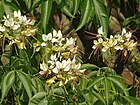Note: This is a project under development. The articles on this wiki are just being initiated and broadly incomplete. You can Help creating new pages.
Crateva nurvala - Large Garlic Pear
Crateva Magna is a shrub or a tree. It will grow upto 2 - 20 metres tall. The tree is harvested from the wild for local use, Mainly as a medicine and source of wood. The plant is often cultivated as an Ornamental, Especially within its native range.
Contents
- 1 Uses
- 2 Parts Used
- 3 Chemical Composition
- 4 Common names
- 5 Properties
- 6 Habit
- 7 Identification
- 8 List of Ayurvedic medicine in which the herb is used
- 9 Where to get the saplings
- 10 Mode of Propagation
- 11 How to plant/cultivate
- 12 Commonly seen growing in areas
- 13 Photo Gallery
- 14 References
- 15 External Links
Uses
Kidney stone, Piles, Cervical odenitis, Swelling, Collyrium, Desentery, Wounds[1].
Parts Used
Stem's bark, Root's bark, Leaf[1].
Chemical Composition
Chemical Investigation of Crataeva nurvala leaves resulted in the isolation of four compounds, Which are Dodecanoic anhydride, Methyl pentacosanoate, Kaemferol-3-O-α-D-glucoside and Quercitin-3-O-α-D-glucoside.[2]
Common names
| Language | Common name |
|---|---|
| Kannada | Mavalinga mara, Holetakki, Holetumbe |
| Hindi | Baran, Barna |
| Malayalam | NA |
| Tamil | Kodikilangu |
| Telugu | Ulimiri, Chendupaddu |
| Marathi | NA |
| Gujarathi | NA |
| Punjabi | NA |
| Kashmiri | NA |
| Sanskrit | Kumaraja, Varuna, Setuvriksha |
| English | Holy garlic pear |
Properties
Reference: Dravya - Substance, Rasa - Taste, Guna - Qualities, Veerya - Potency, Vipaka - Post-digesion effect, Karma - Pharmacological activity, Prabhava - Therepeutics.
Dravya
Rasa
Guna
Veerya
Vipaka
Karma
Prabhava
Habit
Identification
Leaf
| Kind | Shape | Feature |
|---|---|---|
Flower
| Type | Size | Color and composition | Stamen | More information |
|---|---|---|---|---|
| Flowering from December to March |
Fruit
| Type | Size | Mass | Appearance | Seeds | More information |
|---|---|---|---|---|---|
| Fruiting from December to March |
Other features
List of Ayurvedic medicine in which the herb is used
Kaanchanaara Guggulu, Dhanvantari Gritha, Niri, Purim, Malatyadi Tailam, Varunaadi Kashaayam, Varunaadi Gritha, Vaatasaani Taila[1]
Where to get the saplings
Mode of Propagation
How to plant/cultivate
Commonly seen growing in areas
Open forests, Often along streams, Sometimes near the seashore, Occurring mostly along streams in shady locations.
Photo Gallery
References
- ↑ 1.0 1.1 1.2 1.3 ”Karnataka Medicinal Plants Volume-3” by Dr.M. R. Gurudeva, Page No.610, Published by Divyachandra Prakashana, #6/7, Kaalika Soudha, Balepete cross, Bengaluru
- ↑ Indian Journals of Pharmaceutical Science - Chemical constituents of Crataeva nurvala (Buch-ham) leaves
- ↑ [Morphology]
- ↑ [Cultivation]
External Links
- Ayurvedic Herbs known to be helpful to treat Kidney stone
- Ayurvedic Herbs known to be helpful to treat Piles
- Ayurvedic Herbs known to be helpful to treat Cervical odenitis
- Ayurvedic Herbs known to be helpful to treat Swelling
- Ayurvedic Herbs known to be helpful to treat Collyrium
- Ayurvedic Herbs known to be helpful to treat Desentery
- Ayurvedic Herbs known to be helpful to treat Wounds
- Herbs with Stem's bark used in medicine
- Herbs with Root's bark used in medicine
- Herbs with Leaf used in medicine
- Herbs with common name in Kannada
- Herbs with common name in Hindi
- Herbs with common name in Tamil
- Herbs with common name in Telugu
- Herbs with common name in Sanskrit
- Herbs with common name in English
- Habit - Semi-deciduous Tree
- Index of Plants which can be propagated by Seed
- Herbs that are commonly seen in the region of Open forests
- Herbs that are commonly seen in the region of Often along streams
- Herbs that are commonly seen in the region of Sometimes near the seashore
- Herbs that are commonly seen in the region of Occurring mostly along streams in shady locations
- Herbs


